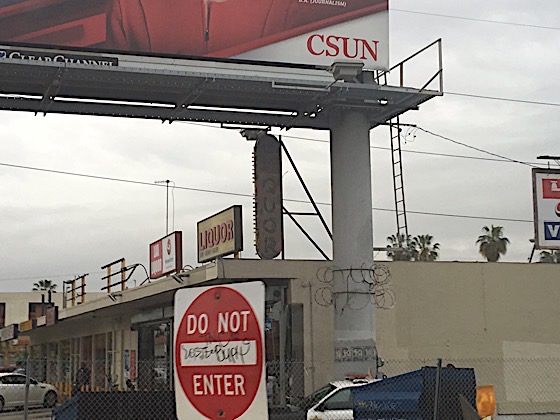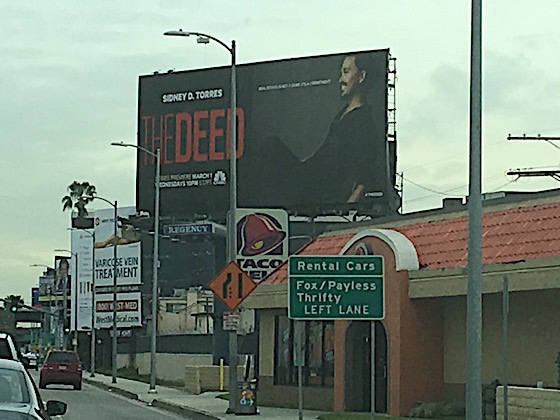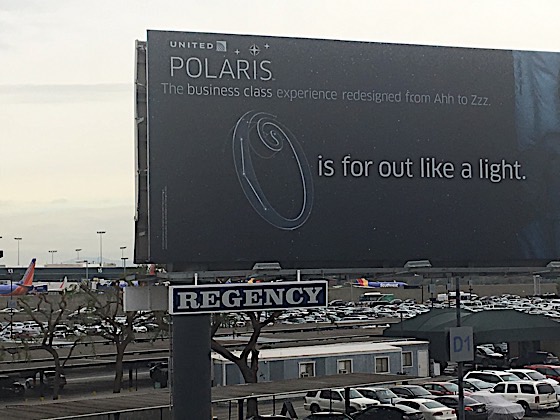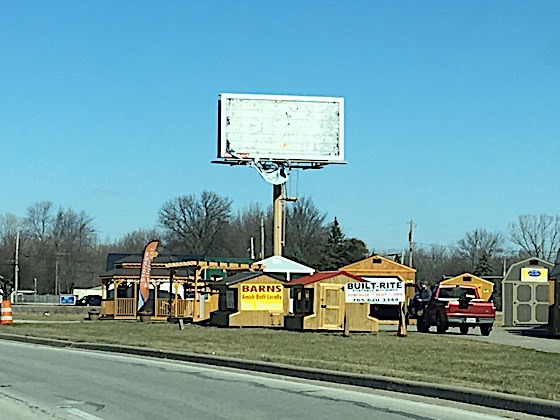Memo From Frank
A recent article stated that the average American will need $1,000,000 in savings to retire comfortably – yet only 5% will achieve it. So what’s the plan? For many people, owning billboards would be a terrific substitute. Just ten wooden billboards could provide annual income of $40,000 or so per year, which is the same amount that $1 million in savings will garner if properly invested. So perhaps the better goal is to create an income stream than trying to save up $1 million in cash. When you consider the fact that 70% of Americans do not have $1,000 in savings, you can see that savings is not a realistic expectation in the modern world. But can you build 10 billboards? That’s readily achievable. And the sooner you start, the better.
Billboards And Graffiti: A Primer

Advertisers express themselves on billboards. But there are others who want to express themselves – but not pay for it. Graffiti is a real menace to billboards in many markets, as evidenced by the photo above which shows a sign with barbed wire around the column. A few minutes with a can of spray paint can do thousands of dollars of damage to the billboard’s vinyl advertisement, not counting the cost of losing ad revenue until the billboard is fixed. So how can you proactively fight graffiti?
The most common forms
There are two types of graffiti: the amateur who simply wants to proclaim “Tom loves Suzy” and the professional who uses graffiti to mark a gang territory or other symbolism. One user is merely opportunistic and the other will go to any lengths to win. Both use the same weapon: spray paint. A simple product that you can buy at Home Depot for $5.
The attraction to billboards
To a graffiti artist, a billboard offers a giant canvas to express themselves. The very strengths that attract paying advertisers to billboards – prime location, high visibility, busy streets – also attract graffiti. In most markets, the billboard offers the most prestigious item to spray paint their message on, so graffiti will always be a constant threat.
Basic prevention
The number one deterrent to graffiti on a billboard is to remove the access ladder, or have it start at a significant distance off the ground. The theory is that if you can’t climb up the sign, then you can’t spray paint on it. And in the case of the amateur attacker who simply wants to paint a love message, this does the trick. While they’d like to express themselves, they don’t want to die trying, and they are not going to bother to bring a ladder from home. However, for the professional graffiti artist, this is not necessarily going to solve the problem.
More advanced steps
So what do you do when simple removal of the vertical access ladder will not the professional graffiti artist back? I had a billboard in Los Angeles that we had to remove the horizontal catwalks off of. That meant that the graffiti artist would have had to dangle with one arm from the top of the sign to spray graffiti on it, which was a turn-off. Billboard owners have also limited access through the use of barbed wire. It seems crazy that you would have to armor a billboard like a prison, but it’s a fact of life in the modern world in some markets.
Impossible situations
Sadly, there’s no solution to short signs in many markets. If the sign is so low to the ground that anyone can reach up and touch it, then there’s no way to limit access. These billboards lasted for decades based on the honor system – and there’s no honor in today’s world. You will sometimes see these type of signs in Los Angeles, Chicago or New York City – typically abandoned. That’s a shame, because they are some very valuable advertising opportunities, but there is simply no way to stop the graffiti.
Another thought
It’s essential to remove graffiti as soon as it’s detected. That punishes the graffiti artist, who put in a great deal of time, effort and risk to do their handiwork for only a day or so of exposure. By denying them the fruits of their labor, you may wear them down and they no longer want to spend time on that project.
Conclusion
Graffiti is a reality in many American markets, and the sign owner must take proactive steps to protect their investment. Most graffiti can be stopped with adequate thought and effort.
Billboard Home Study Course
![]() How to Find a Billboard Location
How to Find a Billboard Location
![]() How to Buy a Billboard
How to Buy a Billboard
![]() How to Build a Billboard
How to Build a Billboard
![]() How to Operate a Billboard
How to Operate a Billboard
![]() How to Rent Ad Space on a Billboard
How to Rent Ad Space on a Billboard
![]() How to Sell a Billboard
How to Sell a Billboard
Get Your Copy Now!
How Billboards Defend Against High Winds By Design

The reason that there are so few catastrophic billboard collapses in the U.S. is that billboards are designed to reduce wind load in an emergency. Just as cars have “crumple zones” to reduce the impact of a crash, and ski boots are meant to break free of the ski in a fall, billboards have a methodology to reduce the impact of dangerous winds. The first step is for the vinyl to blow out and break free of the sign. Then the panels come off, which reduces the wind load to a manageable level. The panels on steel billboards only hang on the sign by gravity – they are not bolted on. In high winds – especially tornadoes – they are going to blow loose and fall off the sign. That’s by design. When you see steel signs that are missing their panels and vinyls, that’s not an accident. That’s how they were designed.
Dealing With Obstructions

Billboards only exist to display the advertiser’s message. If you can’t see or read the advertisement, it’s of no value. All billboards must be constructed with an eye towards being free of obstructions – both now and in the future. So how can you keep your billboard obstacle-free?
“Flag” the sign before you ever build it
Many sign owners are their worst enemies. They build new signs that have immediate obstructions. These are the result of not doing proper due diligence in the form of “flagging” the sign. So how do you “flag” a sign? There are several different methods. The best is to hire a small skyhook cane to lift its boom up to the height of the bottom of the sign and dive up and down the highway and see if there are nay obstructions. The second best way is to buy a commercial “flagging” pole at a surveyors supply and to raise the fiberglass pole up the level of the bottom of the sign and drive it (this will require two people to perform). But if you have zero budget, at least by a helium balloon and some kite string and raise the balloon to the bottom elevation of the sign. This only works on a day with no wind, and is still a weak attempt compared to the other two options – but it’s better than nothing.
Understand what the future obstructions may be
If the sign is clear of obstructions today, what about tomorrow. Trees grow. Undeveloped land can lead to new pad sites and premise signs. So be thinking not only in terms of today, but also the risks of the years ahead. If there are trees in the area, you need to know what type, how fast they grow, and what their ultimate height will be. You may elect to build the sign even higher to protect against the future.
See if you can pay to have the obstruction removed
When an obstruction pops up – whether it’s a flag or a tree or a premise sign – you should immediately see if you can pay to get it altered or removed. I once bought a billboard in downtown Dallas that had been abandoned because there was a parking lot sign right in the middle of it. So I went to the parking lot owner and asked him if I could lower his sign. He said “sure if you pay for it” and about $500 in sign work yielded about $20,000 per year in billboard revenue. I’ve also paid neighbors to have trees removed, flags moved, and many other items.
Be proactive when new obstructions might go up
When you see a neighboring property under construction, it’s worthwhile to call the owner and talk about the benefits to not blocking each other’s signs. Remember that if they block you in one direction, you block them in the other direction. It’s in everyone’s best interest to make sure that no signs are in conflict.
Know your limitations
If the neighbor will not play ball with you, don’t even think about taking matters into your own hands. Cutting or trimming trees on property that you have no permission to touch can land you in huge fines or even jail. And the downside to touching obstructions on state right-of-way are even more severe. Don’t take the attitude that “they’ll never catch me”. The sign owner is the first person they investigate – who else would have the motive to trim that tree?
Conclusion
Signs need to be seen, no blocked. Be proactive about keeping it that way.
Everything You Ever Needed To Know About “Shields”

The nameplate on a billboard has been called a “shield” since the beginning of time. Most sign owners take pride in their “shield” and see that as an essential marketing tool. Many people saw the fascination with “shields” when OutFront Media replaced the shields on thousands of billboards a few years ago at a huge cost. So if the shield is so important, then how do you do it properly.
What name should it be?
Before you can have a shield you have to have a name. A good name. One that you want to promote to the entire world. It doesn’t have to be your name. It needs to be a name that is positive, catchy and simple to remember. Look at the largest owners as a good example. Their shields say “Lamar”, “Clear Channel” and “OutFront”. But other large companies from the past have included “Whiteco”, “Patrick”, “Foster & Kleiser” and “3M”. Some take aways: 1) it should be one or two words and 2) they need to be easy to pronounce and remember. Should you use as name “Blatzianieury”? Nope.
How big?
The sign’s shield should be tastefully proportioned based on the size of the billboard. It is not one size fits all. The shield on a 14’ x 48’ should be much larger than on a 10’ x 20’. Typically, the shield is around 10% of the width of the sign. The worst thing you can do is have the shield obnoxiously large such that it takes away from the ad message, or so small that you can’t read it.
What to make it out of?
The best material is metal, such as aluminum. Two main reasons: 1) it lasts forever and 2) it is thin and does not cast a shadow. Worst idea? Plywood. It warps, casts a shadow, and looks really cheap. You can get a nice shield made at Fastsigns or a similar vendor.
What color?
The most common colors are an exact reflection of the color tables on visibility, which are such color combinations as black & white, red & white, green & white and blue & white. The most attention-getting is the color red, as it is rarely found in nature and garners more visibility (that’s why McDonalds, Wendys and many others use red in their logos).
Lighted?
Rarely are shields illuminated. However, they are sometimes backlit at huge expense on “glamour” signs that might be on the edge of downtown or unusually large or spectacular. But this is only in rare cases. A standard shield is just a piece of aluminum screwed to the skirting of the sign.
Where should it go?
Most sign owners believe that the shield should be in the centered under the billboard face. Others have it flush in the left or right corner. Probably 80% of shields are centered – including most of the largest sign owners.
Should it contain the phone number?
No. Some sign owners think they are doing themselves a favor by putting their phone number in their shield. Bad idea. It makes the shield way to big, irritates advertisers, and is still too small to be read. In today’s age of Google, you don’t need to let people know any more than your name. There are few potential advertisers who call off of such a number, anyway.
Conclusion
A shield is an essential part of any billboard. You definitely should use them and do it properly.
The Impact Of Placing Lights On A Billboard

Do you think a non-lighted billboard would appeal to this advertiser? Probably not. Why? Because a large percentage of their sales are at night. But should you rush to add lights just to rent to this service station? Not necessarily. There are many considerations concerning lighting a billboard.
Certain advertisers must have lights – but not all
There are some businesses that do the majority of their sales at night, such hotels and motels. Others depend on traffic after dark to hit their revenue goals, such as gas stations and restaurants. And then there are others that are not even open at night, such as homebuilders and car dealers. So although your first instinct is that all billboards should have lights, that’s not necessarily the case. While it’s true that a sign with lights rents for more money, you have to take into account the cost of getting lights on the sign – and running them – to see what the advantage really is.
Cost to install
Putting lights on a billboard is not a cheap proposition. You can expect to pay in the thousands of dollars for the fixtures and installation by a licensed electrician. That’s because billboard lights are ballasted, which means that you have a “middleman” between the current and the fixture. In direct current lights, which have no ballast, you have extremely high electric bills and the bulbs don’t last that long. So there really is no way to get around a high price tag on the front end.
Monthly cost to operate
Billboard lights require electricity, maintenance and a significant cost. It can easily run $200 to $300 per month for the power bill alone. So when you are evaluating illuminating a sign, you have to remember that you’ll have to get a few hundred dollars per month in extra rent each month just to pay for it.
Access to electricity issues
And that’s assuming you can get electricity to the sign to begin with. Sometimes getting access to electricity is a very difficult and expensive challenge. I’ve had billboards that would cost $10,000 or more to simply bring the power lines close enough to connect to. In those situations, it’s an easy choice not to illuminate.
Management issues
When you have lights, you have to regularly drive by the sign at night to make sure the lights are working. You also have to change the timeclock at daylight savings, and replace bulbs periodically. Even though these are not huge issues, they definitely can wear you down.
Conclusion
Most signs should be illuminated, but some should not. If you’re looking at building a wooden billboard, for example, you may simply opt to leave the sign non-illuminated, and that’s fine. You won’t be able to rent to a motel, but there are still a huge number of advertisers out there who don’t necessarily need lights.
Why The 30-Sheet Is The Workhorse Of The Outdoor Industry

There is probably no type of billboard that is as hardy and adaptable as the 30-sheet poster. A standard of the industry for over half a century, this sign just seems to have the right fit for virtually any market. So why is this type of sign such a workhorse?
Works in all settings – both highway and secondary road
Whoever originally designed the 30-sheet (which is roughly 12’ x 24’ and is called “30 sheet” because it took 30 sheets of wallpaper to cover it in the early days) did a great deal of due diligence on the right size to be seen on both highways and secondary streets. While it’s only half as large as a standard highway bulletin (which is 14’ x 48’) it still allows for sufficient copy and logo in a highway setting. A 30-sheet sign is like a nice sportscoat that you can use regardless of the occasion.
User-friendly shape
By having a ratio of two times as wide as it is tall, it’s much more shaped like a square than a rectangle. That allows you to have three lines of copy that’s plenty large. It also allows for a large graphic. Some sign shapes make it hard to fit your advertisement design to the billboard specifications, but not the 30-sheet.
Wide acceptance through standardization
30-sheets are identically sized throughout the U.S. They are in the inventory of Lamar, OutFront, Clear Channel and about every other major sign owner. The have been around for over half a century. And they are the most standardized sign in existence, in tandem with their big brother, the 14’ x 48’. If you have ad copy in New York City that fits a 30-sheet, it will also fit in San Francisco. Franchise manuals for McDonalds, etc. all have standard ad designs for 30-sheets in them.
Vinyl wrap gave it a new life
They stopped “posting” ads with wallpaper about 20 years ago, so the 30-sheet would have been obsolete if it relied just on that type of ad. However, the advent of vinyl wrapping of signs brought about all new possibilities for the 30-sheet.
Easy to light
You only need one light fixture to illuminate a 30-sheet. Just one. That’s extremely efficient in both cost to install and cost to operate. They even make light fixtures specifically for 30-sheets.
Conclusion
The 30-sheet is a great sign selection for many different locations and markets. You can rarely go wrong with a 30-sheet, whether it’s a monopole sign or wooden telephone poles. It’s a universal testament to good outdoor design.
A Waste Of An Opportunity

Here we have a vacant sign. The big question is: why is the owner not using the sign to find an advertiser. That’s a huge missed opportunity.
One of the best sources of new advertisers is the sign itself
The average billboard reaches about 50,000 viewers per day. These include most of the potential advertisers for the sign. So why not put a phone number up on the vacant sign to people know who to call to rent it. Better yet, put the words “Sign for Rent” on top of that phone number, so those drivers know that the sign is available. And to get really technical, let’s put those words and phone number in a giant typeface of 4’ or larger letters.
Demonstrates the media
When you use giant words, you demonstrate to potential advertisers how powerful a giant billboard can be. I always say that a billboard is a giant 50’ tall salesman, and that’s a powerful force. Many potential advertisers may not be aware of a billboard as an advertising option, and you will be doing good to remind them of that fact.
Conclusion
You should never let a billboard sit empty. If you don’t have a paying advertiser, then you should use the sign as a tool to find one.
The Market Report
Prices Are Delayed By At Least 15 Minutes
